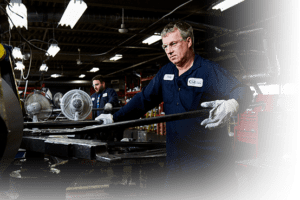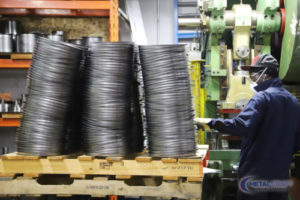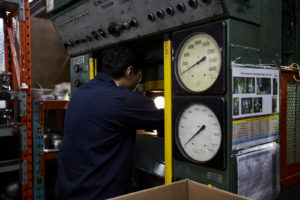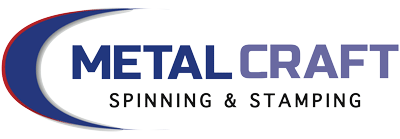Spinning, Stamping, and Hydroforming: Which Works Best for Your Application?
Comments Off on Spinning, Stamping, and Hydroforming: Which Works Best for Your Application?Most manufacturers consider metal spinning, metal stamping, and hydroforming to be specialized and narrowly focused processes, but actually, these metal-forming methods are used in industries as varied as commercial construction, interior design, heating and climate control, and agriculture. Manufacturers use spinning, stamping, and hydroforming methods for products ranging from satellite dishes to funeral urns.
Understanding the benefits of each process as well as where they overlap will help you decide which metal forming technique best suits your application. Below, we’ve assembled an overview of the three main metal forming practices, and we also outline the ways they could benefit your production line.
Metal Spinning
Metal spinning , also known as metal turning or spin forming, is a fabrication process that uses a rotating spindle to form metal into axially symmetrical, hollow cylindrical products or components. The process can be automated using CNC technology, manual equipment, or hydraulic controls, and is used for shaping ductile, formable metals such as aluminum, copper, and brass.
, also known as metal turning or spin forming, is a fabrication process that uses a rotating spindle to form metal into axially symmetrical, hollow cylindrical products or components. The process can be automated using CNC technology, manual equipment, or hydraulic controls, and is used for shaping ductile, formable metals such as aluminum, copper, and brass.
The metal spinning process is highly efficient and inexpensive, which makes it particularly useful for large-scale production runs. Since the tooling can be easily modified, adjustments can be made during production with minimal expense and downtime. In addition, the process produces very little material waste, further reducing production overhead.
Metal spinning is used to create products with diameters as small as 1” and up to 8’, which allows manufacturers to create a variety of products, including musical instruments, mixing bowls, automotive components, lighting fixtures, roofing, and satellite dishes.
Metal Stamping
Metal stamping uses compressive force and pre-formed dies to create shapes from a flat metal sheet or blank. It is a highly efficient process that is easily automated and requires very little labor when compared to other fabrication methods. At its most basic, the metal stamping process involves feeding a sheet of metal between a press and the die tool. When the press is activated, it applies pressure to the metal, forcing it into the die to create the desired shape.
uses compressive force and pre-formed dies to create shapes from a flat metal sheet or blank. It is a highly efficient process that is easily automated and requires very little labor when compared to other fabrication methods. At its most basic, the metal stamping process involves feeding a sheet of metal between a press and the die tool. When the press is activated, it applies pressure to the metal, forcing it into the die to create the desired shape.
Although the overall stamping process is simple, it requires the use of highly specialized equipment, depending on the product. To facilitate efficient and accurate fabrication, manufacturers have developed a variety of stamping techniques, including progressive, deep-drawn, and fourslide stamping, among others. Each method is engineered to produce specific products and parts.
Metal presses can be used to create a variety of shapes and useful features through punching, bending, notching, and embossing. The versatility, accuracy, and repeatability of the metal stamping process make it ideal for manufacturing automotive components, farm equipment, fixtures, brackets, and ventilation system components.
Hydroforming
Hydroforming is a metal fabrication method that uses pressurized fluid to shape ductile metal into components using pre-shaped plates or dies. A tube or flat sheet of metal is placed inside the hydroforming chamber along with the die. The hydroforming press forces water into the chamber, pressing the tube or sheet against the die to create the intended shape.
is a metal fabrication method that uses pressurized fluid to shape ductile metal into components using pre-shaped plates or dies. A tube or flat sheet of metal is placed inside the hydroforming chamber along with the die. The hydroforming press forces water into the chamber, pressing the tube or sheet against the die to create the intended shape.
The hydroforming process offers a variety of advantages over other methods, particularly for shaping highly complex, intricate, or asymmetrical components from tubes of ductile metal. By creating components from one solid piece of metal, hydroforming produces stronger, seamless shapes with exceptional stiffness and durability. In addition, hydroforming allows manufacturers to create components using a one-step process, thereby reducing production time and increasing the amount of material that can be processed at a time.
As a highly cost-effective and efficient manufacturing method, hydroforming is favored by manufacturers for lighting fixtures, satellite antennae, and a variety of automotive components.
Which Method Best Fits Your Application?
When selecting the right metal forming method for your application, it is important to consider the intended application of the product being manufactured, as well as material requirements, product size, and production volume. Each technique offers unique benefits for specific applications.
Metal Spinning Benefits
Metal spinning is a highly efficient and cost-effective process that is ideal for use with products that involve high-pressure applications. The primary benefits of metal spinning include:
- Cost-effective for both high- and low-volume production
- Creates products without seams
- Increases product strength and reliability
- Easy to modify part designs
- Quick production for shorter lead times
Metal Stamping Benefits
Metal stamping is ideal for the creation of extremely precise components of varying complexity with high repeatability, which makes it an excellent option for both high- and low-volume production. Benefits of metal stamping include:
- Exceptional precision
- Good for complex shapes
- Low-cost
- Time efficient
- High accuracy and repeatability
- Excellent product quality
- Minimal scrap
Hydroforming Benefits
Hydroforming is ideal for creating complex components with minimal need for secondary finishing, and is excellent for both large and small production runs. Hydroforming benefits include:
- Versatile design options
- Exceptional accuracy
- Detailed components
- Better material strength
- Reduced need for secondary operations
- Less material usage
- Lightweight components
Can’t Decide? We Can Help
At Metal Craft, we manufacture metal components of almost any shape or size, offering a full spectrum of metal spinning, metal stamping, and hydroforming services. As fourth-generation metal forming specialists, we’re proud of our long-term business relationships with our valued customers.
Contact us and let’s get started! Our highly trained experts will work with you to design and fill your next order, and we’re committed to exceeding your expectations.


